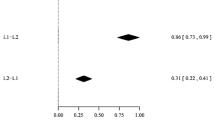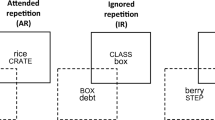Abstract
The authors used a unilingual and bilingual primed lexical decision task to investigate priming effects produced by attended and ignored words. In the unilingual experiment, accelerated lexical decisions to probe target words resulted when the word matched the preceding target word, whereas slowed lexical decisions to probe target words resulted when the word matched the preceding ignored nontarget word. In the bilingual (English-Spanish) experiment, between-language, rather than within-language, priming manipulations were used. Although the ignored repetition negative priming effect replicated across languages, cross-language attended repetition positive priming did not. This dissociation of priming effects in the inter- versus intralanguage priming conditions contradicts episodic retrieval accounts of negative priming that deny the existence of selective inhibitory processes. On the other hand, these results support an extension of inhibition-based accounts of negative priming, because they indicate that inhibition can operate at two levels of abstraction—local word and global—language simultaneously.
Similar content being viewed by others
References
Anderson, J. R. (1983). A spreading activation theory of memory.Journal of Verbal Learning & Verbal Behavior,22, 261–295.
Anderson, M. C., &Spellman, B. A. (1995). On the status of inhibitory mechanisms in cognition: Memory retrieval as a model case.Psychological Review,102, 68–100.
Carroll, J. B., Davies, P., &Richman, B. (1982).American heritage word frequency book. New York: American Heritage.
Chen, H.-C., &Ng, M.-L. (1989). Semantic facilitation and translation priming effects in Chinese-English bilinguals.Memory & Cognition,17, 454–462.
Collins, A. M., &Loftus, E. F. (1975). A spreading activation theory of semantic processing.Psychological Review,85, 407–428.
Costin, D. (1988). MacLab: A Macintosh system for psychology labs.Behavior Research, Methods, Instruments, & Computers,20, 197–200.
De Groot, A. M. B., &Nas, G. L. (1991). Lexical representation of cognates and noncognates in compound bilinguals.Journal of Memory & Language,30, 90–123.
Forbach, G. B., Stanners, R. F., &Hochhaus, L. (1974). Repetition and practice effects in a lexical decision task.Memory & Cognition,2, 337–339.
Fox, E. (1995). Negative priming from ignored distractors in visual search: A review.Psychonomic Bulletin & Review,2, 145–173.
Fox, E. (1996). Cross-language priming from ignored words: Evidence for a common representational system in bilinguals.Journal of Memory & Language,35, 353–370.
Francis, W. N., &Kučera, H. (1982).Frequency analysis of English usage. Boston: Houghton Mifflin.
Frenck-Mestre, C., &Prince, P. (1997). Second language autonomy.Journal of Memory & Language,37, 481–501.
Fuster, J. M. (1997).The prefrontal cortex: Anatomy, physiology, and neuropsychology of the frontal lobe (3rd ed.). Philadelphia: Lippincott-Raven.
Gernsbacher, M. A., &Faust, M. (1995). Skilled suppression. In F. Dempster & C. Brainerd (Eds.),Interference and inhibition in cognition (pp. 295–327). New York: Academic Press.
Grainger, J., &Beauvillain, C. (1988). Associative priming in bilinguals: Some limitations of interlingual facilitation effects.Canadian Journal of Psychology,42, 261–273.
Green, D.W. (1986). Control, activation, and resource: A framework and a model for the control of speech in bilinguals.Brain & Language,27, 210–223.
Green, D. W. (1993). Towards a model of L2 comprehension and production. In R. Schreuder & B. Weltens (Eds.),The bilingual lexicon (pp. 249–277). Amsterdam: John Benjamins.
Heredia, R. R. (1997). Bilingual memory and hierarchical models: A case for language dominance.Current Directions in Psychological Science,6, 34–39.
Houghton, G., &Tipper, S. P. (1994). A model of inhibitory mechanisms in selective attention. In D. Dagenbach & T. H. Carr (Eds.),Inhibitory processes in attention, memory, and language (pp. 53–112). San Diego: Academic Press.
Kane, M. J., May, C. P., Hasher, L., Rahhal, T., &Stolzfus, E. R. (1997). Dual mechanisms of negative priming.Journal of Experimental Psychology: Human Perception & Performance,23, 632–650.
Keatley, C. W., &de Gelder, B. (1992). The bilingual primed lexical decision task: Cross-language priming disappears with speeded responses.European Journal of Cognitive Psychology,4, 273–292.
Keele, S. W., &Neill, W. T. (1978). Mechanisms of attention. In E. C. Carterette & M. P. Friedman (Eds.),Handbook of perception (Vol. 9, pp. 3–47). New York: Academic Press.
Kirsner, K., Smith, M., Lockhart, R., King, M., &Jain, M. (1984). The bilingual lexicon: Language-specific units in an integrated network.Journal of Verbal Learning & Verbal Behavior,23, 519–539.
Kroll, J. F., &Curley, J. (1988). Lexical memory in novice bilinguals: The role of concepts in retrieving second language words. In M. Grunenberg, P. Morris, & R. Sykes (Eds.),Practical aspects of memory (pp. 389–395). London: Wiley.
Kučera, H., &Francis, E. (1967).Computational analysis of presentday American English. Providence, RI: Brown University Press.
Langley, L. K., Overmier, J. B., Knopman, D. S., &ProdHomme, M. M. (1998). Inhibition and habituation: Preserved mechanisms of attentional selection in aging and Alzheimers disease.Neuropsychology,12, 353–366.
Levin, J. R., &Neumann, E. (1999). Testing for predicted patterns: When interest in the whole is greater than in some of its parts.Psychological Methods,4, 44–57.
Logan, G. D. (1988). Toward an instance theory of automatization.Psychological Review,95, 492–527.
Logan, G. D. (1990). Repetition priming and automaticity: Common underlying mechanisms?Cognitive Psychology,22, 1–35.
Malley, G. B., &Strayer, D. L. (1995). Effect of stimulus repetition on positive and negative identity priming.Perception & Psychophysics,57, 657–667.
May, C. P., Kane, M. J., &Hasher, L. (1995). Determinants of negative priming.Psychological Bulletin,118, 35–54.
Meyer, D. E., Schvaneveldt, R. W., &Ruddy, M. G. (1975). Loci of contextual effects on visual word recognition. In P. M. A. Rabbitt & S. Dornic (Eds.),Attention and performance V (pp. 98–118). New York: Academic Press.
Moore, C. M. (1994). Negative priming depends on probetrial conflict: Where has all the inhibition gone?Perception & Psychophysics,56, 133–147.
Motter, B. C. (1998). Neurophysiology of visual attention. In R. Parasuraman (Ed.),The attentive brain (pp. 51–70). Cambridge, MA: MIT Press.
Neely, J. H. (1991). Semantic priming effects in visual word recognition: A selective review of current findings and theories. In D. Besner & G. Humphreys (Eds.),Basic processes in reading: Visual word recognition (pp. 264–336). Hillsdale, NJ: Erlbaum.
Neill, W. T. (1997). Episodic retrieval in negative priming and repetition priming.Journal of Experimental Psychology: Learning, Memory, & Cognition,23, 1291–1305.
Neill, W. T., &Valdes, L. A. (1992). The persistence of negative priming: Steady-state or decay?Journal of Experimental Psychology: Learning, Memory, & Cognition,18, 565–576.
Neill, W. T., &Valdes, L. A. (1996). Facilitatory and inhibitory aspects of attention. In A. F. Kramer, M. G. H. Coles, & G. D. Logan (Eds.),Converging operations in the study of visual selective attention (pp. 77–106). Washington, DC: American Psychological Association.
Neill, W. T., Valdes, L. A., Terry, K. M., &Gorfein, D. S. (1992). The persistence of negative priming: II. Evidence for episodic trace retrieval.Journal of Experimental Psychology: Learning, Memory, & Cognition,18, 993–1000.
Neumann, E. (1993, June).Evidence for a relationship between interference and negative priming in selective attention. Poster presented at the meeting of the American Psychological Society, Chicago.
Neumann, E., Cherau, J. F., Hood, K. L., &Steinnagel, S. L. (1993). Does inhibition spread in a manner analogous to spreading activation?Memory,1, 81–105.
Neumann, E., &DeSchepper, B. G. (1991). Costs and benefits of target activation and distractor inhibition in selective attention.Journal of Experimental Psychology: Learning, Memory, & Cognition,17, 1136–1145.
Neumann, E., &DeSchepper, B. G. (1992). An inhibition-based fan effect: Evidence for an active suppression mechanism in selective attention.Canadian Journal of Psychology,46, 1–40.
Pavio, A., Clark, J. M., &Lambert, W. E. (1988). Bilingual dualcoding theory and semantic repetition effects on recall.Journal of Experimental Psychology: Learning, Memory, & Cognition,14, 163–172.
Pavio, A., Yuille, J. C., &Madigan, S. A. (1968). Concreteness, imagery, and meaningfulness values for 925 nouns.Journal of Experimental Psychology Monographs,76(1, Pt. 2), 1–25.
Posner, M. I., &Rafal, R. D. (1987). Cognitive theories of attention and rehabilitation of attentional deficits. In R. J. Meier, L. Diller, & A. L. Benton (Eds.),Neuropsychological rehabilitation (pp. 182–201). London: Churchill & Livingston.
Ruthruff, E., &Miller, J. (1995). Negative priming depends on ease of selection.Perception & Psychophysics,57, 715–723.
Schadler, M., &Thissen, D. M. (1981). The development of automatic word recognition and reading skill.Memory & Cognition,9, 132–141.
Schiller, P. H. (1966). Developmental study of color-word interference.Journal of Experimental Psychology,72, 105–108.
Schooler, C., Neumann, E., Caplan, L. J., &Roberts, B. R. (1997). Continued inhibitory capacity throughout adulthood: Conceptual negative priming in younger and older adults.Psychology & Aging,12, 667–674.
Segalowitz, N. (in press). Automaticity and attentional skill in fluent performance. In H. Riggenbach (Ed.),Perspectives on fluency. Ann Arbor: University of Michigan Press.
Stadler, M. A., &Hogan, M. E. (1996). Varieties of positive and negative priming.Psychonomic Bulletin & Review,3, 87–90.
Tipper, S. P. (1985). The negative priming effect: Inhibitory priming by ignored objects.Quarterly Journal of Experimental Psychology,37A, 571–590.
Tipper, S. P. (1992). Selection for action: The role of inhibitory mechanisms.Current Directions in Psychological Science,1, 105–109.
Tipper, S. P., &Driver, J. (1988). Negative priming between pictures and words in a selective attention task: Evidence for semantic processing of ignored stimuli.Memory & Cognition,16, 64–70.
Tipper, S. P., Lortie, C., &Baylis, G. C. (1992). Selective reaching: Evidence for action-centered attention.Journal of Experimental Psychology: Human Perception & Performance,18, 891–905.
Tipper, S. P., &Milliken, B. (1996). Distinguishing between inhibition and episodic retrieval based accounts of negative priming. In A. F. Kramer, M. Coles, & G. D. Logan (Eds.),Converging operations in the study of visual selective attention (pp. 337–364). Washington, DC: American Psychological Association.
Tipper, S. P., Weaver, B., Cameron, S., Brehaut, J. C., &Bastedo, J. (1991). Inhibitory mechanisms of attention in identification and localization tasks: Time course and disruption.Journal of Experimental Psychology: Learning, Memory, & Cognition,17, 681–692.
Tzelgov, J., &Eben-Ezra, S. (1992). Components of the between-language semantic priming effect.European Journal of Cognitive Psychology,4, 253–272.
Tzelgov, J., Henik, A., &Leiser, D. (1990). Controlling Stroop interference: Evidence from a bilingual task.Journal of Experimental Psychology: Learning, Memory, & Cognition,16, 760–771.
von Studnitz, R. E., &Green, D. W. (1997). Lexical decision and language switching.International Journal of Bilingualism,1, 3–24.
Author information
Authors and Affiliations
Corresponding author
Rights and permissions
About this article
Cite this article
Neumann, E., McCloskey, M.S. & Felio, A.C. Cross-language positive priming disappears, negative priming does not: Evidence for two sources of selective inhibition. Mem Cogn 27, 1051–1063 (1999). https://doi.org/10.3758/BF03201234
Received:
Accepted:
Published:
Issue Date:
DOI: https://doi.org/10.3758/BF03201234




